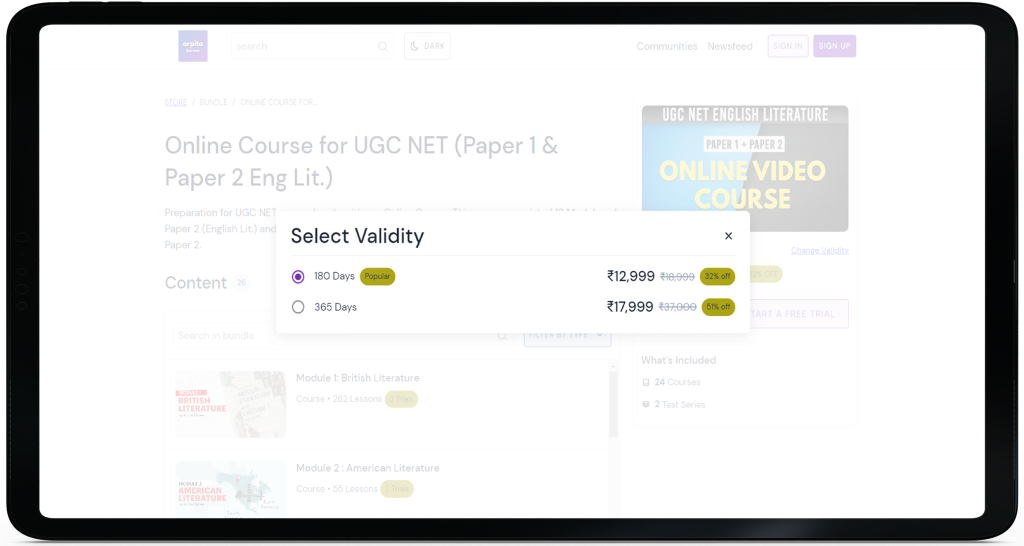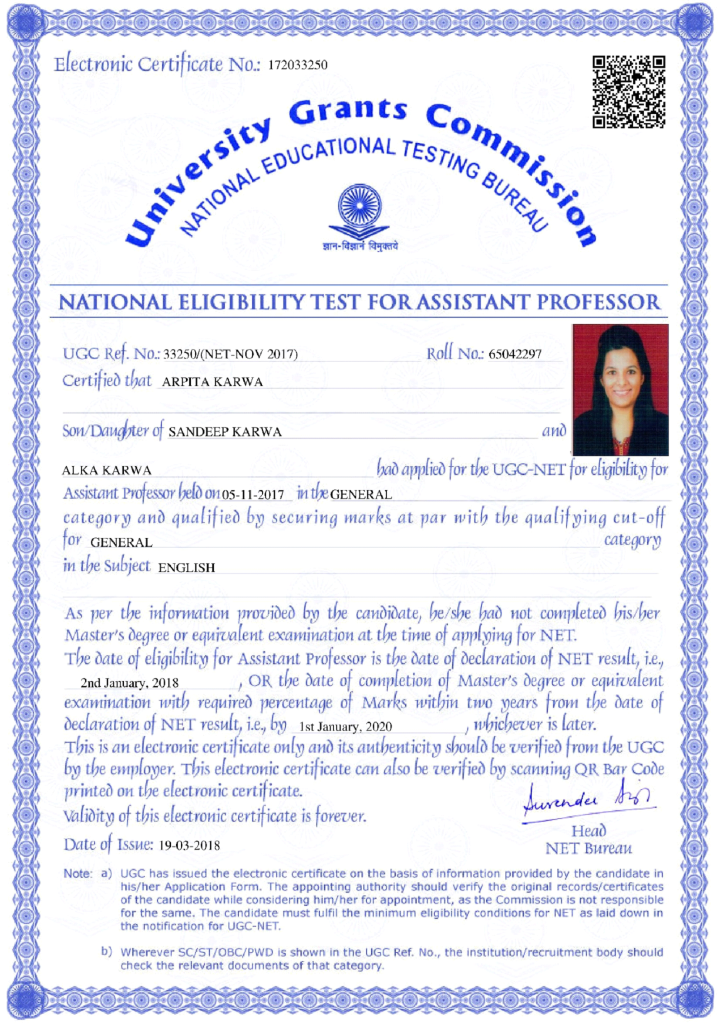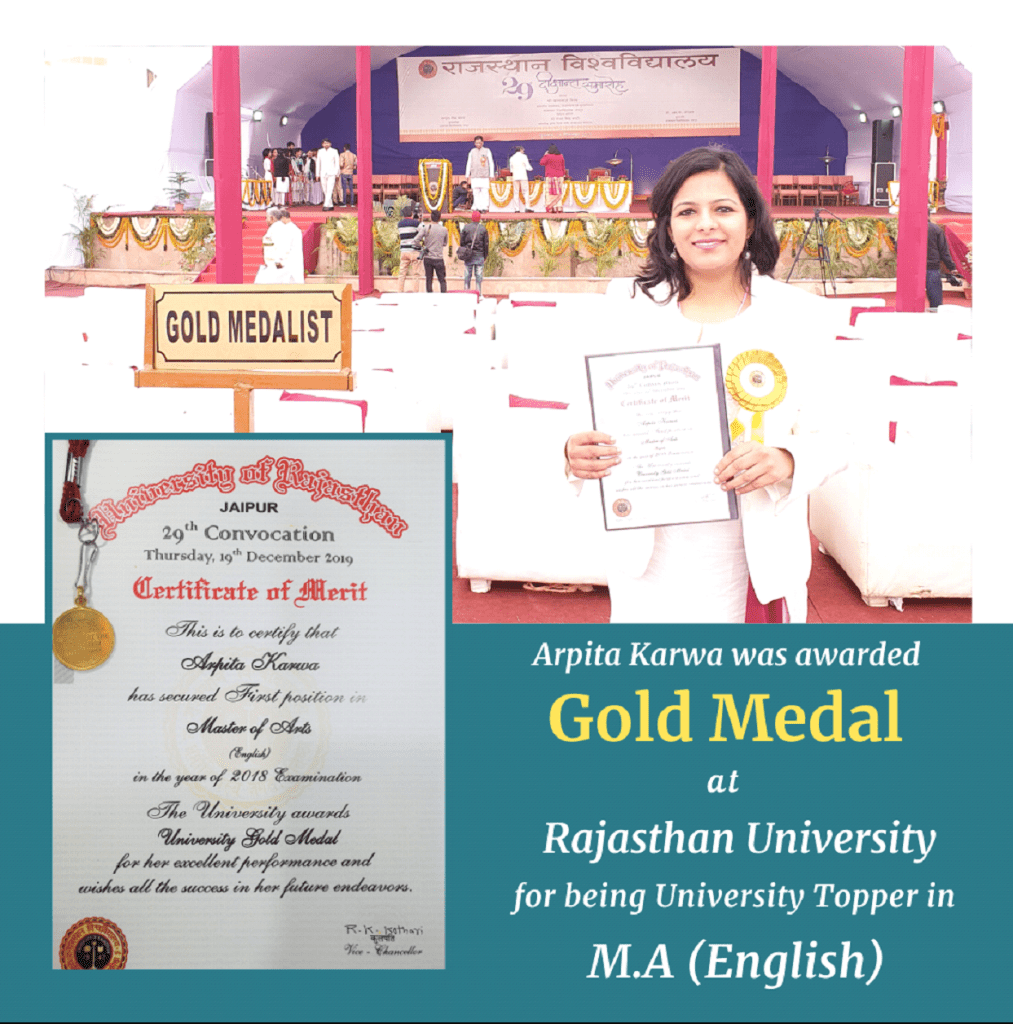August 2016 : Paper 3
October 19, 2022 2025-10-13 13:29August 2016 : Paper 3
August 2016 : Paper 3
Q.1) Who was the original English translator for Of Grammatology?
[1] Samuel Weber
[2] G.C. Spivak
[3] Paul de Man
[4] Jean-luc Nancy
Answer: 2
Q.2) Which figure explains the meaning of the play Everyman at its conclusion?
[1] Angel
[2] Knowledge
[3] Doctor
[4] Good Deeds
Answer: 3
Q.3) Who in his preface to Joseph Conrad’s The Secret Agent makes the following remark?
“the achievement of modern art is that it has ceased to recognize the categories of tragic and comic or the dramatic classifications ‘tragedy’ and ‘comedy’, and views of life as tragicomedy.”
[1] August Strindberg
[2] Luigi Pirandello
[3] D.H. Lawrence
[4] Thomas Mann
Answer: 4
Q.4) The Restoration period’s most characteristic drama, the “comedy of manners”, was gradually replaced by “sentimental drama” in response to shifts in the audience’s taste. Which of the following statements best represents the difference between these two types of comedy?
[1] Comedies of manners expose human follies to laughter, sentimental comedies provoke sympathetic tears for the characters’ faults.
[2] Comedies of manners were commercially successful; sentimental comedies were not.
[3] Comedies of manners were critically successful; sentimental comedies were not.
[4] Comedies of manners were written in rhymed couplets; sentimental comedies were written in blank verse.
Answer: 1
Q.5) The epitaph on her tombstone that Emily Dickinson composed herself reads
[1] The List is done
[2] Redemption – Brittle Lady
[3] Judge tenderly – of Me
[4] Called Back
Answer: 4
Q.6) Shel is a character in Virginia Woolf’s novel ……………
[1] Mrs. Dalloway
[2] To the Lighthouse
[3] The Waves
[4] Orlando
Answer: 4
Q.7) Thomas Mann described the theme of one of his fictional works as “the fascination of death, the triumph of disorder in a life founded on order.” Which of his works was he referring to?
[1] Buddenbrooks
[2] Death in Venice
[3] The Magic Mountain
[4] Doctor Faustus
Answer: 2
Q.8) In the middle of the story the narrator in Oroonoko digresses from the central tale of Oroonoko’s revolt and tells of various expeditions taken in company with Oroonoko.
What is the purpose of these digressions, according to the narrator?
[1] To illustrate the richness of the country of Surinam
[2] To enliven the dullness of the central narrative
[3] To give proof of Oroonoko’s daring and curiosity
[4] To convince the reader that the narrator is indeed an eye-witness to the events described
Answer: 3
Q.9) In 1941 John Day Company in New York published Jawaharlal Nehru’s autobiography under the title
[1] Toward Freedom
[2] In Search of Freedom
[3] Toward Independence
[4] In Search of Independence
Answer: 1
Q.10) “In honoured poverty thy voice did weave/songs consecrate to truth and liberty, – / Deserting
these, thou leavest me to grieve” are lines from “To Wordsworth”. Who is the poet?
[1] Coleridge
[2] Shelley
[3] Byron
[4] Keats
Answer: 2
Q.11) Speaking of Siva is an English translation by A.K. Ramanujan of some …………. Bhakti poems composed by Virasaiva saints.
[1] Konkani
[2] Tamil
[3] Telugu
[4] Kannada
Answer: 4
Q.12) In Beowulf, Beowulf accuses Unferth of
I. pagan beliefs
II. killing his own “kith and kin”
III. “unchecked atrocity”
IV. unprovoked war
The right combination according to the code is
[1] I and II
[2] II and III
[3] I and IV
[4] I and III
Answer: 2
Q.13) Charles Dickens opined that “no man ever before had the art of making himself mentally so like a woman since the world began.” He was acknowledging the quality of the work of which writer?
[1] Walter Scott
[2] William Mackpeace Thackeray
[3] George Meredith
[4] George Eliot
Answer: 4
Q.14) In his well-known essay “Politics and the English Language”, George Orwell provides representative examples of what common faults?
[1] Staleness of imagery and lack of precision
[2] Lack of precision and incorrect formatting
[3] Incorrect formatting and staleness of imagery
[4] Staleness of precision and lack of imagery
Answer: 1
Q.15) According to Roland Barthes, the “writerly text” is
[1] a unique expression of the writer’s individual genius
[2] consumed by way of a seemingly unitary meaning
[3] linked to active participation of the reader in the establishment of the text’s meaning
[4] immediately accessible to the reader
Answer: 3
Q.16) The Canadian Nobel Laureate Alice Munro is known for her
[1] novels
[2] poems
[3] short stories
[4] novellas
Answer: 3
Q.17) A critical question Eliot’s Prufrock poses, so important to an understanding of his character, is
[1] “To be or not to be?”
[2] “What are you thinking of?”
[3] “Do I dare?”
[4] “Is there nothing in your head?”
Answer: 3
Q.18) A test of listening comprehension is a test of
[1] Receptive skill
[2] Productive skill
[3] Hearing skill
[4] Phonology
Answer: 1
Q.20) Colin Clout, Spenser’s persona in The Shepheardes Calendar appears in two of these ecologues.
I. ‘June’
II. ‘February’
III. ‘November’
IV. ‘December’
The right combination according to the code is
[1] I and IV
[2] II and III
[3] III and IV
[4] I and III
Answer: 1
Q.20) Which character in Crime and Punishment speaks of St. Petersburg as a city of half crazy people filled with gloomy, harsh and strange influences?
[1] Razumikhin
[2] Peter Petrovich Luzhyn
[3] Raskolnikov
[4] Svidrigailov
Answer: 4
Q.21) At the conclusion of Swift’s Modest Proposal, the narrator declares that he has “not the least personal interest in endeavouring to promote this necessary work, having no other motive than the public good of my country.” What evidence does the narrator give that his advice is free from other motives?
I. The narrator is Irish and a sworn bachelor, unlikely to father children.
II. He has no children who will be affected by the scheme, and thus cannot make money from it.
III. His wife is past childbearing, and thus the narrator cannot benefit by “breeding” her.
IV. The narrator is English, and therefore this scheme will not affect him personally.
The right combination according to the code is
[1] I and II
[2] II and III
[3] IV and III
[4] I and III
Answer: 2
Q.22) The Grammar Translation Method was historically used in teaching
[1] Greek and French
[2] Greek and Latin
[3] Latin and Scandinavian
[4] French and German
Answer: 2
Q.23) Most of the titles of Aldous Huxley’s novels are taken from various literary works. Match the titles of his novels with the works from which they have been borrowed :
I. Brave New World A. Blake’s The Marriage of Heaven and Hell
II. The Doors of Perception B. Marlowe’s Edward II
III. Antic Hay C. Wordsworth’s “The Tables Turned”
IV. Those Barren Leaves D. Shakespeare’s The Tempest
The right code according to the key is :
[1] I-D, II-C, III-A, IV-B
[2] I-D, II-A, III-B, IV-C
[3] I-C, II-D, III-A, IV-B
[4] I-B, II-C, III-D, IV-A
Answer: 2
Q.24) “There is no set and there are no wings; the stage is empty and in almost total darkness. This is in order that right from the beginning the audience shall receive the impression of being present not at a performance of a carefully rehearsed play, but at a performance of a play that suddenly happens.”
Which of the following plays have the above stage directions?
[1] Eugene Ionesco’s The Chairs
[2] August Strindberg’s A Dream Play
[3] Luigi Pirandello’s Six Characters in Search of an Author
[4] Samuel Beckett’s Krapp’s Last Tape
Answer: 3
Q.25) In Thomas Hobbes’s grand metaphor in Leviathan, a commonwealth is like ………….
[1] a great ship piloted by one man, but managed by the efforts of many.
[2] an artificial man imbued with the strength of many men.
[3] an octopus whose many tentacles represent the competing interests of men.
[4] an ostrich, which thrusts its head in the sand to avoid danger and self examination.
Answer: 2
Q.26) The word “Calamus”, a kind of water reed referenced in the title Calamus Poems, is a symbol for Whitman of
[1] water nymphs
[2] male companions
[3] the spirit of American democracy
[4] the impending American Civil War
Answer: 2
Q.27) Assertion (A) : The world is becoming increasingly multilingual.
Reason (R) : To monolingual Anglophones it may look like everyone in the world is learning English.
In the context of these two statements
[1] Both (A) and (R) are true and (R) is the correct explanation of (A).
[2] Both (A) and (R) are true, but (R) is not the correct explanation of (A).
[3] (A) is true, but (R) is false.
[4] (A) is false, but (R) is true.
Answer: 2
Q.28) The first scene in Girish Karnad’s Tughlaq opens in front of a …………..
[1] court
[2] temple
[3] tavern
[4] shop
Answer: 1
Q.29) What is the final word in Joyce’s Ulysses?
[1] Love
[2] Sex
[3] Death
[4] Yes
Answer: 4
Q.30) Which Victorian novel has the subtitle “New Foes with an Old Face”?
[1] Hypatia
[2] Sybil
[3] Pendennis
[4] Phineas Finn
Answer: 1
Q.31) In which of the following poems does W.H. Auden call 1930s “a low dishonest decade”?
[1] “September 1, 1939”
[2] “In Memory of W.B. Yeats”
[3] “No Change of Place”
[4] “The Watershed”
Answer: 1
Q.32) Two examples of closet drama are
I. Byron’s Manfred
II. Shelley’s Cenci
III. Marlowe’s Edward II
IV. Shaw’s Widower’s Houses
The right combination according to the code is
[1] I and II
[2] I and III
[3] II and III
[4] II and IV
Answer: 1
Q.33) Who among the following postcolonial critics worked on the fiction of Joseph Conrad in his/her early career?
[1] Edward Said
[2] G.C. Spivak
[3] Homi Bhabha
[4] Dipesh Chakrabarty
Answer: 1
Q.34) In The Trial what is the main character Joseph K’s job?
[1] He works in a bank
[2] He’s a politician
[3] He works in a government office
[4] He is an entomologist
Answer: 1
Q.35) Which of the following best summarises the structural approach to literature?
[1] Meaning is inherent in the word itself.
[2] A language’s history explains how it works.
[3] Meaning is generated through relationships in a system of signs.
[4] Binary oppositions are to be avoided at all costs.
Answer: 3
Q.36) The Australian poet A.D. Hope is best known for his
I. elegies
II. Satires
III. Sonnets
IV. Doggerel verses
The right combination according to the code is
[1] I and II
[2] II and IV
[3] I and III
[4] II and III
Answer: 1
Q.37) At the conclusion of Gulliver’s Travels, Gulliver argues that his motivation for telling the tale is
[1] to entertain his readers
[2] to inform and instruct mankind
[3] to assist the British nation in enlarging her colonies
[4] to produce a travelogue of genius and learning
Answer: 2
Q.38) Match the character with the play :
Character
I. Everyman in His Humour
II. Volpone
III. Epicoene
IV. The Alchemist
Play
A. Bonario
B. Subtle
C. Knowles
D. Morose
[1] I-B, II-D, III-C, IV-A
[2] I-B, II-C, III-A, IV-D
[3] I-C, II-D, III-B, IV-A
[4] I-C, II-A, III-D, IV-B
Answer: 4
Q.39) Which of the following novels by Nuruddin Farah deals with foreign aid?
[1] Maps
[2] Gifts
[3] Secrets
[4] Links
Answer: 2
Q.40) In the house of Holinesse in Faerie Queene, Redcross learns repentance and the way to heaven from Dame Caelia and her daughters, who are named :
[1] Fidelia, Speranza and Charissa
[2] Fidelia, Speranza and Una
[3] Fidelia, Speranza and Humilita
[4] Fidelia, Speranza and Zele
Answer: 1
Q.41) A new historical reading, above everything else, is influenced by the philosophy of
[1] Jacques Derrida
[2] Jacques Lacan
[3] Michel Foucault
[4] Theodore Adorno
Answer: 3
Q.42) The Behaviourist Theory is explained in terms of
[1] conditioning
[2] behaviour
[3] attitude
[4] personality
Answer: 1
Q.43) Who is the author of the poems “Elegy for Mrs. Virginia Woolf” and “William Butler in Limbo”?
[1] Keith Douglas
[2] W.H. Auden
[3] Sidney Keyes
[4] Stephen Spender
Answer: 3
Q.44) The form of Dryden’s Essay of Dramatic Poesy is
[1] an essay
[2] an epic poem
[3] a dialogue
[4] a play
Answer: 3
Q.45) Which Flemish poet is Jacques Derrida related to?
[1] Anton Bergmann
[2] Karel L. Ledeganck
[3] Jan Frans Willems
[4] Jan Van Beers
Answer: 4
Q.46) In Bunyan’s Pilgrim’s Progress which of the following are found in the Slough of Despond?
[1] Hope, great expectations, and dreams of the future.
[2] Joy and happiness.
[3] Fears and doubts, discouraging apprehensions, sinful thoughts.
[4] False doctrines.
Answer: 3
Q.47) Who among the following wrote a book on the life and works of Dante Gabriel Rossetti?
[1] Graham Greene
[2] Evelyn Waugh
[3] William Golding
[4] Kingsley Amis
Answer: 2
Q.48) Among the Romantic poets William Blake was a total artist, undertaking many roles usually separated. In his last years he produced some of his finest engravings. Which of the following was NOT illustrated by Blake?
[1] The Book of Job
[2] The rape of Leda
[3] Virgil’s Pastorals
[4] The works of Dante
Answer: 2
Q.49) Identify the two Indian texts translated by the Orientalist William Jones
I. Abhignanamshakuntalam
II. Katha Sarita Sagar
III. Mahabharatha
IV. Manusmriti
The right combination according to the code is
[1] I and II
[2] II and III
[3] I and IV
[4] III and IV
Answer: 3
Q.50) Which work by a famous poet does Thomas de Quincey refer to as “the feeblest and least interesting” of his writings “being substantially a mere versification, like a metrical multiplication table, of common places, the most mouldy with which criticism has baited its rat-traps”?
[1] John Dryden’s An Essay of Dramatic Poesy
[2] Alexander Pope’s An Essay on Criticism
[3] Shelley’s Defence of Poetry
[4] Sidney’s An Apologie for Poetry
Answer: 2
Q.51) “On or about December 1910 human character changed,” Virginia Woolf wrote. A more assertive declaration, “It was in 1915 the old world ended”, was made by a novelist in one of his/her novels, picking a date of far more historical moment, the point when an entire cultural tradition seemed to end in war. Name the novelist and the novel.
[1] D.H. Lawrence – Kangaroo
[2] Aldous Huxley – Brave New World
[3] Virginia Woolf – Mrs. Dalloway
[4] James Joyce – Ulysses
Answer: 1
Q.52) Semiotics, the general science of signs, traces its lineage to
I. Edmund Husserl
II. Charles Sanders Pierce
III. Ferdinand de Saussure
IV. Claude Levi-Strauss
The right combination according to the code is
[1] II and III
[2] I and III
[3] III and IV
[4] II and IV
Answer: 1
Q.53) After the Norman Conquest of 1066, Norman French was the dominant language used by
[1] ordinary people
[2] religious clerics
[3] the upper classes
[4] farmers
Answer: 3
Q.54) Which novel of George Eliot was read with pleasure by Queen Victoria and also commissioned for two paintings of scenes as a mark of recognition?
[1] Romola
[2] Scenes of Clerical Life
[3] Adam Bede
[4] Middlemarch
Answer: 3
Q.55) In More’s Utopia there are 54 cities, all built on a similar plan and distributed over the island such that each city is surrounded by agricultural lands. Who does the agricultural labour in Utopia?
[1] Agricultural labour is performed by slaves.
[2] Adulterers and other criminals are forced to work on farms.
[3] All citizens take two-year stints at farm work.
[4] Farm labourers are brought in from allied countries.
Answer: 3
Q.56) Direct Method in English Language Teaching is also known as
[1] Functional Method
[2] Natural Method
[3] Indirect Approach
[4] Inductive Approach
Answer: 2
Q.57) Vikram Seth’s From Heaven Lake is a/an
[1] verse novel
[2] exhibition of poster poetry
[3] travel book
[4] collection of philosophical essays
Answer: 3
Q.58) Which of the following is NOT a punishment given by God to Adam and Eve as a consequence of tasting the forbidden fruit?
[1] ‘Children thou shalt bring/In sorrow forth’
[2] Expulsion from Eden
[3] ‘Cursed is the ground for thy sake, thou in sorrow / Shalt eat thereof all the days of thy life’
[4] ‘Dust shalt eat all the days of life’
Answer: 4
Q.59) …………… attempted to draw a distinction between two kinds of Truth, a theological Truth ‘drawn from the word and oracles of God’ and determined by faith, and a ‘scientific’ Truth based on the light of nature and the dictates of reason.
[1] Treatise on the laws of Ecclesiastical Piety
[2] Literature and Pulpit in Medieval England
[3] The Advancement of Learning
[4] The New Atlantis
Answer: 3
Q.60) In Defence of Poesy what arguments does Sidney make for considering the Biblical Psalms poetry?
I. They are written in meter.
II. They originated in Church choirs
III. They were written by a single author.
IV. David uses imagery and personification to portray faith.
The right combination according to the code is
[1] II and III
[2] I and III
[3] I and IV
[4] II and IV
Answer: 3
Q.61) In Herman Melville’s well-known story
“Bartleby the Scrivener”, what does the word “scrivener” mean?
[1] Pasting clerks in a Dead Letter Office
[2] Articled clerks in an accountant’s office
[3] Clerks who copy legal documents by hand.
[4] Clerks who serve as personal assistants to judges.
Answer: 3
Q.62) “Medicine is my lawful wife” ………….. once said “and literature is my mistress.”
[1] Franz Kafka
[2] Leo Tolstoy
[3] Anton Chekhov
[4] Albert Camus
Answer: 3
Q.63) The critical concept of a “Willing suspension of disbelief” owes its origin to Chapter …………… of Biographia Literaria.
[1] IX
[2] XIV
[3] XII
[4] XV
Answer: 2
Q.64) Thomas Carlyle coined two evocative phrases, ‘Everlasting Nay’ and ‘Everlasting Yea’ to suggest the swing in the national mood of his times. The phrases came from
[1] On Heroes, Hero-Worship and the Heroic in History
[2] Past and Present
[3] Sartos Resartus
[4] The French Revolution
Answer: 3
Q.65) Marxist literary criticism stresses that
I. class is an imaginary concept
II. the economy is the final determinant of cultural production
III. texts reveal the economic conditions of the time in which they were written.
IV. the critic should see the work as self-sufficient
The right combination according to the code is
[1] I and II
[2] II and III
[3] II and IV
[4] I and III
Answer: 2
Q.66) St. Augustine brought Christianity, and the Latin language enriched Old English by giving it the capacity to talk about ……………
[1] common experience
[2] place names
[3] abstract ideas
[4] agricultural concepts
Answer: 3
Q.67) Who makes the following speech in Henrik Ibsen’s Ghosts?
“I almost think we are all ghosts, all of us …
It isn’t just what we have inherited from
our father and mother that walks in us.
It’s all sorts of dead ideas, and all sorts of
old and obsolete beliefs. They’re not alive
in us; but they are lodged in us and we
can never free ourselves from them ….
There must be ghosts the whole country over,
as thick as the sands of the sea.”
[1] Mrs. Alving
[2] Engstrand
[3] Pastor Manders
[4] Oswald
Answer: 1
Q.68) Which of these lines is NOT in Pope’s Essay on Criticism?
[1] “Wretches hang that jury men may dine”
[2] “A little learning is a dangerous thing”
[3] “Fools rush in where angels fear to tread”
[4] “The sound must seem an echo to the sense”
Answer: 1
Q.69) One of the principles of materials preparation for language learning is that
[1] complex material should be chosen
[2] any kind of material can be chosen
[3] grading of materials should be done
[4] a small amount of material should be introduced
Answer: 3
Q.70) R.K. Narayan’s “A Horse and Two Goats” is set in a tiny village called …………..
[1] Idupali
[2] Samudram
[3] Kritam
[4] Mallur
Answer: 3
Q.71) Kishori Mohan Ganguli, an Indian translator working in the last quarter of 19 century, is best known for his free English translation of
[1] the Ramayana
[2] the Mahabharata
[3] the Bhagavad Gita
[4] Upanishad Sangraha
Answer: 2
Q.72-75) Read the following poem and answer the questions, 72 to 75 :
Remembered Village
If you love your country, he said, why are you here?
Say, you are tired of hearing about
all that wonder-that-was-India crap.
It is tea that’s gone cold: time to brew a fresh pot.
But what wouldn’t you give for one or two places in it?
Aunt’s house near Kulittalai, for instance.
It often gets its feet wet in the river,
and coils of rain hiss and slither on the roof.
Even the well boils over.
Her twelve-house lane is bloated with the full moon,
and bamboos tie up the eerie riverfront
with a knot of toads.
A Black Pillaiyar temple squats at one end of the village –
stone drum that is beaten thin on festivals by the devout.
Bells curl their lips at the priest’s rustic Sanskrit.
Outside, pariah dogs kick up an incense of howls.
And beyond the paddy fields,
dead on time, the Erode Mail rumbles past,
a light needle of smoke threading remote villages
such as yours that are routinely dropped by schedules,
and no trains are ever missed.
Q.72) The opening question best suggests
[1] unremitting patriotism
[2] a condition of exile
[3] a sense of detachment
[4] uncalled-for petulance
Answer: 2
Q.73) As stated who often wets feet in the river?
[1] The house
[2] The Aunt
[3] Kullitalai
[4] The poet
Answer: 1
Q.74) “Bellows curl their lips at the priest’s rustic Sanskrit” is an example of
[1] Oxymoron
[2] Paradox
[3] Personification
[4] Synecdoche
Answer: 3
Q.75) The words “no trains are ever missed” in their context mean that
[1] the poet is punctual about boarding trains
[2] all trains stop in the village but none is missed
[3] the remote village is not a stop for trains; so no train is ever missed
[4] the poet remembers all the trains boarded from the village
Answer: 3
























